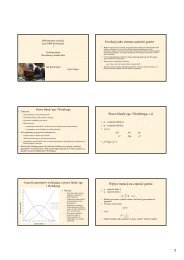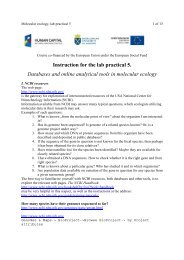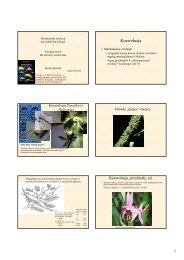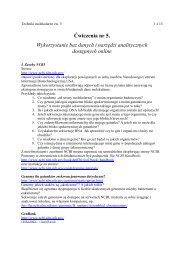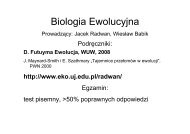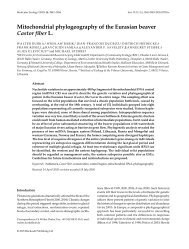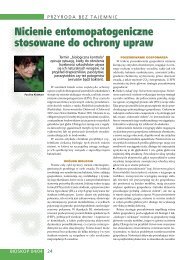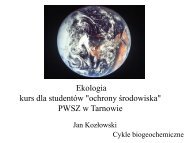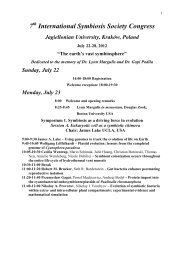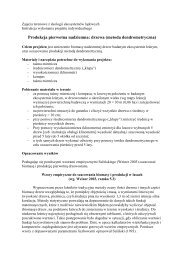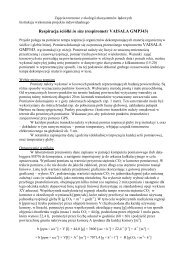Strong association between a single gene and fertilization efficiency ...
Strong association between a single gene and fertilization efficiency ...
Strong association between a single gene and fertilization efficiency ...
You also want an ePaper? Increase the reach of your titles
YUMPU automatically turns print PDFs into web optimized ePapers that Google loves.
PGDH <strong>and</strong> sperm competition M. Konior <strong>and</strong> others 311<br />
(Konior et al. 2001; Kozielska et al. 2004) was associated with<br />
the Pgdh locus, we paired 46 virgin SS females <strong>and</strong> 59 virgin<br />
FF females with males from the 2001 stock culture. The male<br />
was exchanged every day for the first 3 days, such that each<br />
female mated with three males. Three males were used to<br />
reduce the effects of occasional male infertility on female<br />
fecundity. On the fifth day, all eggs laid by each female were<br />
counted.<br />
(g) Male harmfulness<br />
To determine whether there was an <strong>association</strong> <strong>between</strong> male<br />
Pgdh genotype <strong>and</strong> the fecundity of their mates, virgin females<br />
from stock cultures were paired during 10 days with one SS<br />
(nZ81) or FF (nZ77) males. Males were replaced every<br />
2 days with another male of the same genotype, so that each<br />
female was paired with five males in turns. Two days after the<br />
last male was removed, we counted the eggs laid by each<br />
female.<br />
3. RESULTS<br />
(a) Re-analysis of previous data<br />
The proportion of offspring fathered by the two males<br />
mating with the same female was influenced by their<br />
genotype. The proportion of offspring fathered by SS<br />
males that mated with a female previously mated with an<br />
FF male was 0.79G0.25 (meanGs.d., nZ14) while this<br />
proportion was 0.33G0.41 (nZ5) for FF males that<br />
mated with a female previously mated with an SS male.<br />
The difference in <strong>fertilization</strong> <strong>efficiency</strong> <strong>between</strong> the<br />
genotypes was significant (Mann–Whitney UZ13,<br />
PZ0.042).<br />
(b) New data<br />
The proportion of offspring fathered by the two males<br />
mating with the same female was also significantly<br />
influenced by their genotype, with SS males achieving a<br />
greater paternity than FF males (figure 1, F 1,20 Z8.72,<br />
pZ0.007). By contrast, the female genotype did not<br />
significantly affect the relative paternity of males of the two<br />
alternative Pgdh genotypes (F 1,20 Z0.61, pZ0.44). The<br />
interaction <strong>between</strong> male <strong>and</strong> female genotype was also<br />
not significant (F 1,20 Z2.95, pZ0.10).<br />
There was no evidence that female fecundity was<br />
influenced by their Pgdh genotype. The fecundity of FF<br />
females (meanGs.d.Z129.6G64.9) was not significantly<br />
different (F 1,103 Z12.37, pZ0.13) from the fecundity of<br />
SS females (meanGs.d.Z109.6G67.8). By contrast, the<br />
fecundity of females was influenced by the genotype of<br />
their mate. Females paired with a SS male laid 60.7G52.8<br />
eggs, whereas females paired with a FF male laid 82.0G<br />
42.6 eggs (F 1,156 Z7.76, pZ0.006). Thus, males with the<br />
genotype associated with higher <strong>fertilization</strong> <strong>efficiency</strong> had<br />
a negative impact on the fecundity of their partners<br />
compared to males with the genotype associated with<br />
lowest <strong>fertilization</strong> <strong>efficiency</strong>.<br />
The frequency of genotypes at the locus Pgdh changed<br />
significantly in the stock population over the 3 years of<br />
laboratory rearing. While the frequency of heterozygotes<br />
was 22% in 2001 (i.e. shortly after the population was<br />
brought to the laboratory; nZ42 females, nine heterozygotes<br />
<strong>and</strong> 33 SS homozygotes), all females (nZ40)<br />
genotyped in 2004 were homozygous for the S allele<br />
(Fisher exact: pZ0.003).<br />
proportion of eggs<br />
fertilised by the 2nd male<br />
1.0<br />
0.8<br />
0.6<br />
0.4<br />
0.2<br />
0<br />
female FF<br />
female SS<br />
Figure 1. Proportion of eggs fertilized by the second male<br />
mating with the female; filled bars, SS males; open bars, FF<br />
males; error bars, st<strong>and</strong>ard deviation.<br />
4. DISCUSSION<br />
The results of our controlled mating experiments revealed<br />
a strong <strong>association</strong> <strong>between</strong> the <strong>fertilization</strong> success of<br />
males <strong>and</strong> their Pgdh genotype. Bulb mite males with the<br />
SS genotype at Pgdh fathered a significantly greater<br />
proportion of offspring than competing FF homozygote<br />
males. Two lines of evidence support the view that this<br />
difference in <strong>fertilization</strong> <strong>efficiency</strong> cannot be explained by<br />
a possible difference in inbreeding <strong>between</strong> the FF <strong>and</strong> SS<br />
sub-populations. First, <strong>and</strong> most importantly, the<br />
inbreeding associated with the founding of the two subpopulations<br />
was determined by their initial effective<br />
population size of 52 (2N individuals, as each of the<br />
founding pair contributed the same number of progeny)<br />
for the FF sub-population <strong>and</strong> 80 for the SS subpopulations.<br />
Since the sub-populations quickly exp<strong>and</strong>ed,<br />
the possible difference in inbreeding was mostly due to this<br />
initial bottleneck event, with a DF (an increase in<br />
inbreeding coefficient) of 1/52Z0.02 for the FF subpopulation<br />
<strong>and</strong> 1/80Z0.012 SS subpopulation. Such a<br />
relatively low level of inbreeding is unlikely to significantly<br />
affect <strong>fertilization</strong> <strong>efficiency</strong> of males. Konior et al. (2005)<br />
reported a 53% decline in <strong>fertilization</strong> success after full-sib<br />
mating (FZ0.25). Assuming that the decrease in <strong>fertilization</strong><br />
<strong>efficiency</strong> is linearly associated with the level of<br />
inbreeding, the difference in inbreeding <strong>between</strong> the FF<br />
<strong>and</strong> SS sub-populations could account for roughly a 1.6%<br />
((0.02K0.012)!212%) of the difference in <strong>fertilization</strong><br />
<strong>efficiency</strong>. This value is an order of magnitude lower than<br />
the observed effect (i.e. 34% for matings with FF females,<br />
<strong>and</strong> 71% for matings with SS females).<br />
The second piece of evidence that differences at the<br />
Pgdh locus are associated with differences in <strong>fertilization</strong><br />
<strong>efficiency</strong> comes from our re-analysis of the data reported<br />
by Kołodziejczyk et al. (2002). In that study differences in<br />
<strong>fertilization</strong> <strong>efficiency</strong> <strong>between</strong> males of alternative genotype<br />
could not stem from differences in inbreeding<br />
because all males came from the same population, yet<br />
SS males had a ca 58% higher <strong>fertilization</strong> <strong>efficiency</strong> than<br />
FF males. Thus the competitive advantage of SS males<br />
was about the same in the two independent experiments<br />
reported here.<br />
A potential caveat of our experiments is that difference<br />
in male reproductive success was measured at the adult,<br />
not egg, stage, making possible that genotypic differences<br />
in egg to adult survival could account for the different<br />
reproductive success of males. However, in another<br />
Proc. R. Soc. B (2006)



